Website translation is essential; we are here to help you make it happen. If you’re curious about the best approach in 2024, we’ve got you covered! Whether you’re a business owner or simply interested, we will guide you through translating everything. If you ever find yourself browsing websites in languages you don’t understand? Do you want to make your site more welcoming to people who speak different languages?
Look no further! Numerous tools are available to assist you with this task. This article is your guide to translating your website content with ease! We’ll walk you through the top methods, offering step-by-step instructions that are simple to follow. Whether you’re using different browsers or devices, we’ve got you covered!
According to Statista, as of January 2024, there are around 5.35 billion internet users worldwide. However, English speakers comprise less than 20% of this global internet user population. Additionally, approximately 51% of websites primarily use English language, as indicated by research from W3Techs. This underscores the importance of website translation, considering that around 80% of internet users are non-English speakers.
Why you May Need To translate a website?
After exploring the compelling research background presented earlier, you might already recognize the significance of translating a website. However, if you’re still undecided, here are some clear-cut reasons why website translation is essential.
Expanding Audience Reach: Translating a website allows you to connect with a broader audience by offering content in multiple languages, tapping into new markets, and attracting diverse customers.
Enhancing User Experience: Translating your website improves accessibility and comprehension for non-English speakers, making it easier for them to navigate and engage with your content.
Boosting Search Engine Visibility: By providing content in multiple languages, your website becomes more visible on search engines, which can improve its competitiveness and ranking.
Fostering Trust and Credibility: A multilingual website demonstrates your commitment to serving diverse audiences, which builds trust and credibility with visitors.
Ensuring Legal Compliance: Translating your website ensures compliance with legal requirements in different regions where specific languages may be mandated for certain types of content.
How To Translate a Website: Top 3 Easy Methods 2024
Now that you know situations where translation might be necessary, let’s explore how to translate a website.
- Using Browser Built-In Translation Features
- Using Online Translation Tools
- Manual Translation
1. Using Browser Built-In Translation Features
Modern web browsers such as Google Chrome, Firefox, Safari, and Microsoft Edge offer built-in translation features that automatically translate web pages into the user’s preferred language. This provides a quick and convenient way to access translated content without the need for additional tools or plugins.
2. Using Online Translation Tools
There are numerous online tools available, such as Google Translate, DeepL, and Microsoft Translator, that offer more advanced translation capabilities. These tools allow you to translate entire websites or specific sections of content with greater accuracy and customization options.
3. Manual Translation
For greater control and accuracy, manual translation by professional translators or bilingual individuals remains a viable option. While more time-consuming than automated methods, it ensures linguistic accuracy and cultural sensitivity, particularly for websites with specialized or technical content.
Using Browser Built-In Translation Features
Let’s explore how to translate a website on most browsers, such as Chrome, Firefox, Safari, and Edge.
- How to translate a website: Google Chrome
- How to translate a website: Firefox
- How to translate a website: Safari
- How to translate a website: Microsoft Edge
1. How to translate a website: Google Chrome
When encountering a webpage in a foreign language, Chrome offers a translation feature to help you understand the content.
- Open Google Chrome and go to the website you wish to translate.
- Look for the “Translate” option on the right side of the address bar and click on it (click Translate ).
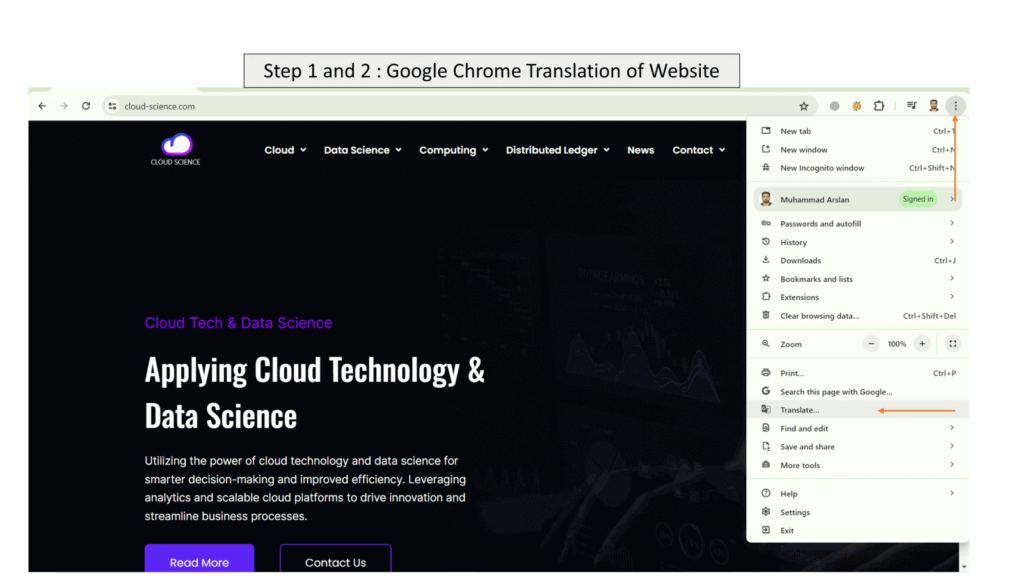
3. Choose your preferred language from the options provided.
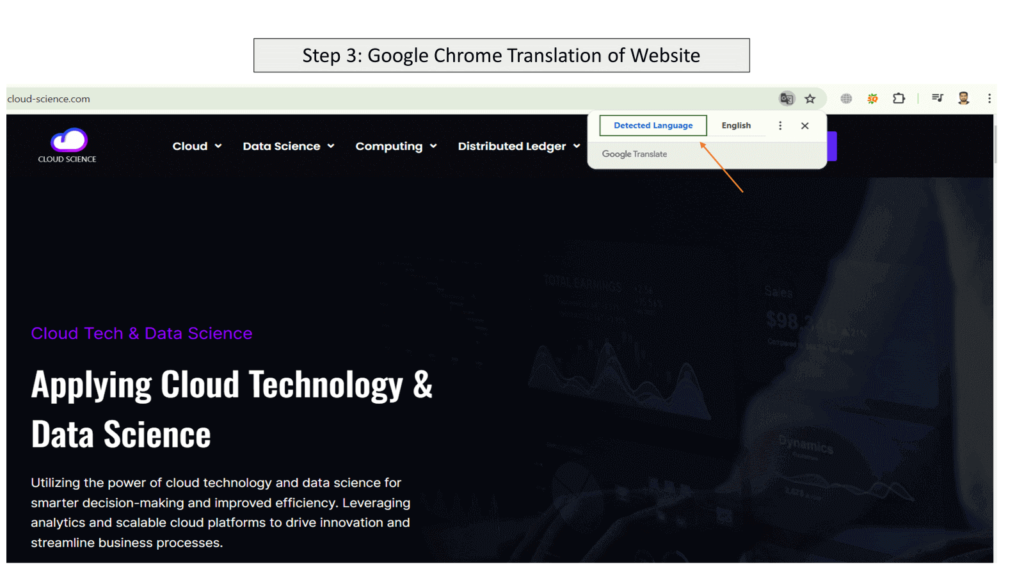
4. Try refreshing the webpage if the translation feature doesn’t work initially. If it still doesn’t, right-click anywhere on the page and select “Translate to [Language].”
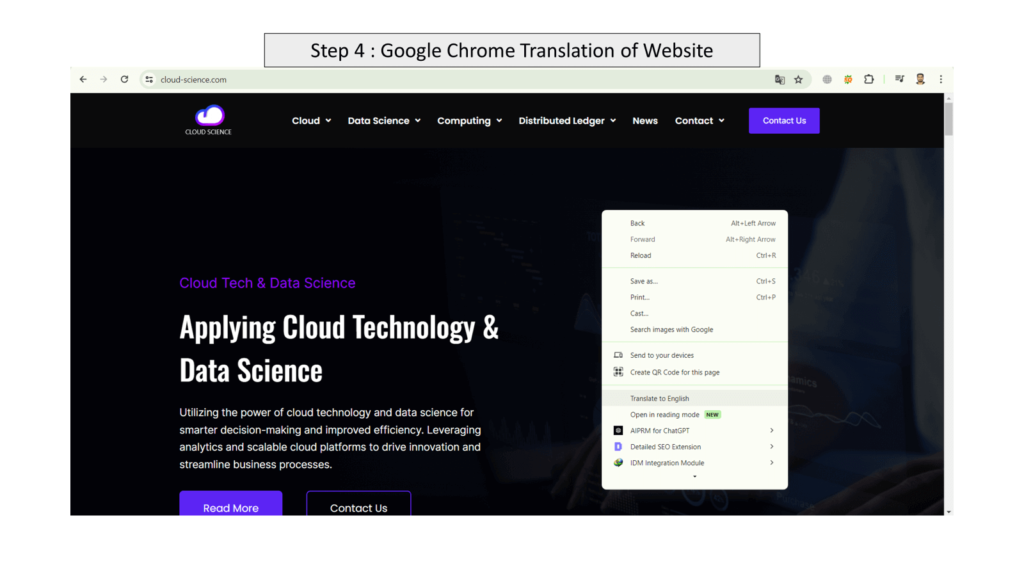
- Chrome will translate the webpage for you.
- Here we have translated our website into Arabic language.
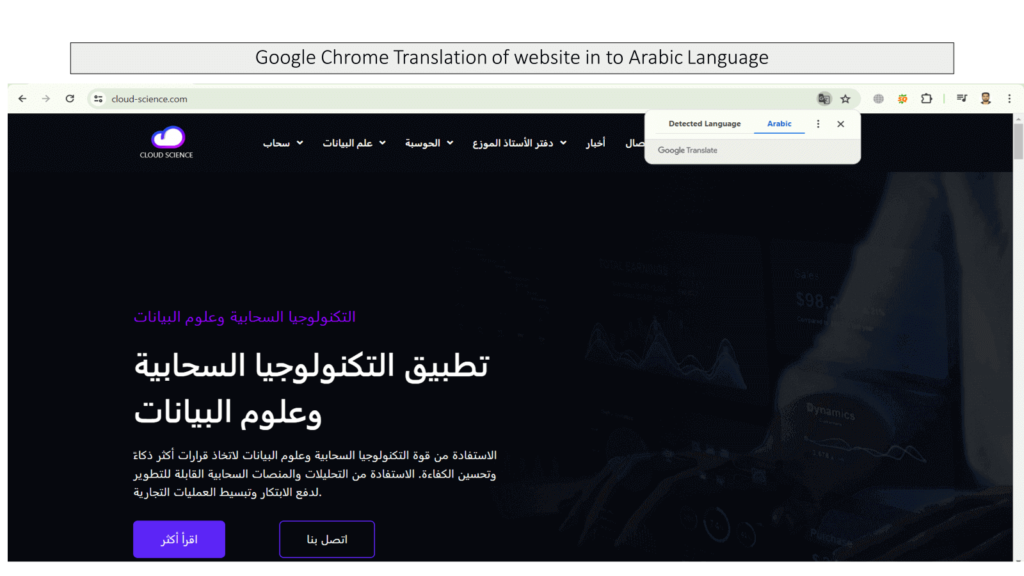
2. How to translate a website: Mozilla Firefox
- Open Firefox and visit the website you want to translate.
- Click on the three horizontal lines in the upper right corner to open the menu.
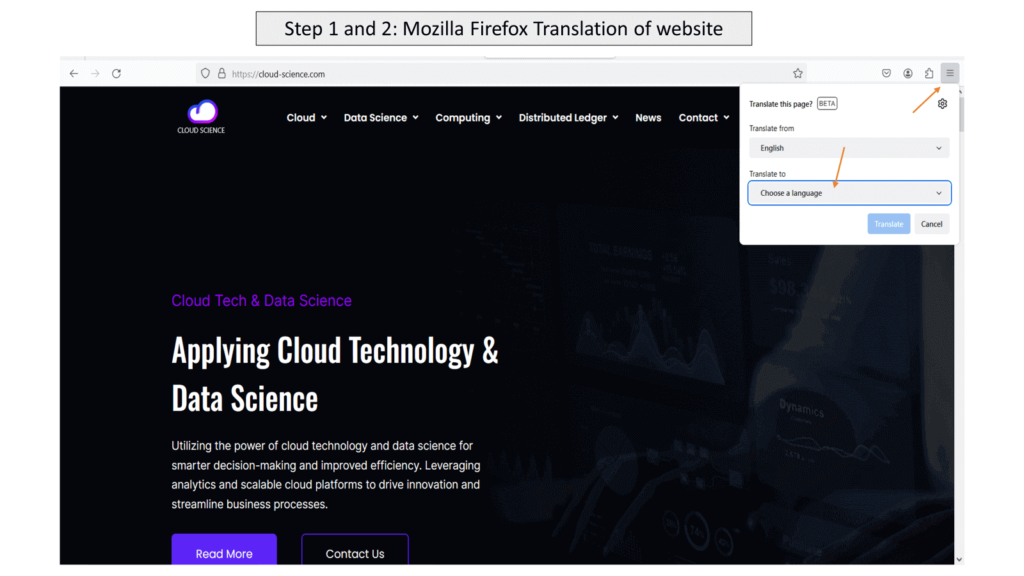
- Select “Translate” from the menu options, and Firefox will automatically translate the page using its built-in feature.
- When you visit a webpage in a supported language, the translation panel will open automatically. If it does not open, click the translation icon in the toolbar or select the Translate page from the menu.
- Here, we have translated our website into the French language.
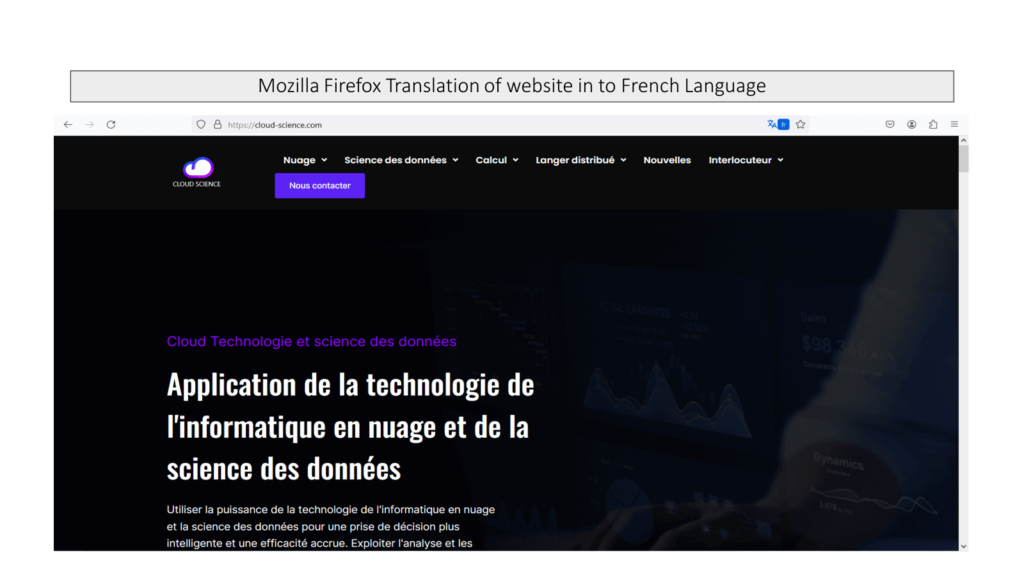
3. How to translate a website: Microsoft edge
- When you open a page, Microsoft Edge will prompt you with a “Translate page” message similar to Chrome.
- Once the translation is ready, the address bar briefly displays the word “Translated.”
- If you want Edge to automatically translate pages into this language every time, you can tick the “Always translate pages from” option.
- If the popup doesn’t show up, you can right-click on the website page Translate icon in the address bar will appear. Lets take an example of website Orange.fr
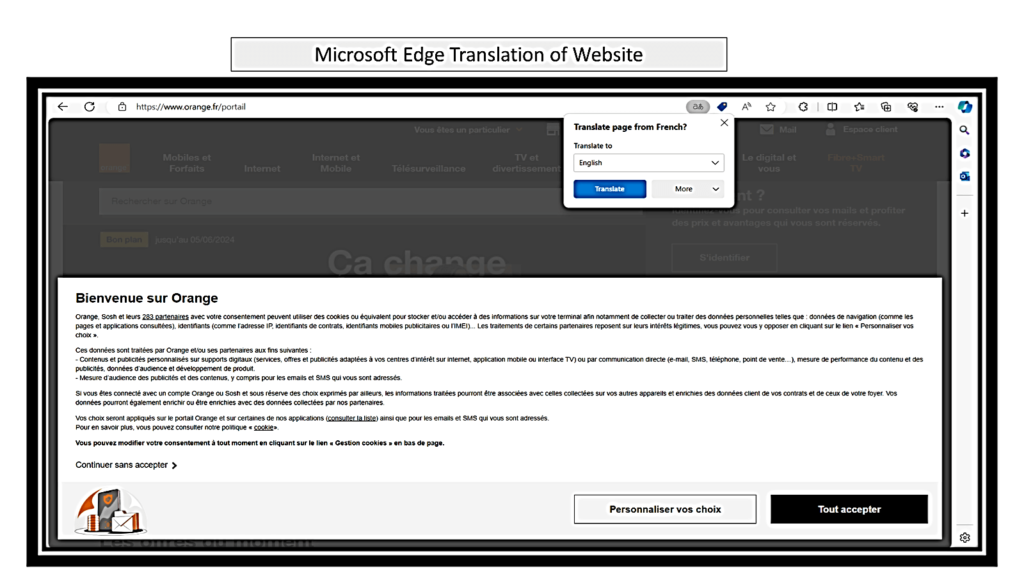
4. How to translate a website: Safari
Here’s a streamlined guide to translating web pages in Safari:
- Make sure you’re using Safari version 14 or newer.
- Go to the non-English webpage you want to translate.
- Click the translate icon on the right side of the address bar.
- Choose “Translate to English” to convert the page to English.

- To see the original page, click the translate icon again and select “View Original.”
- Click the translate icon for other languages, then “Preferred Languages.”
- Add languages using the plus icon and set your primary language.
- Close settings, and now you can translate into added languages by clicking the translate icon again.

Creating a Multilingual Website Using TranslatePress
TranslatePress is a user-friendly WordPress plugin that allows you to translate your website content into multiple languages with ease. Here’s a step-by-step guide on how to create a multilingual website using TranslatePress:
Step 1: Install and Activate TranslatePress
- Log in to your WordPress dashboard.
- Navigate to the “Plugins” section and click “Add New.”
- Search for “TranslatePress” and install the plugin.
- Once installed, activate TranslatePress on your website.
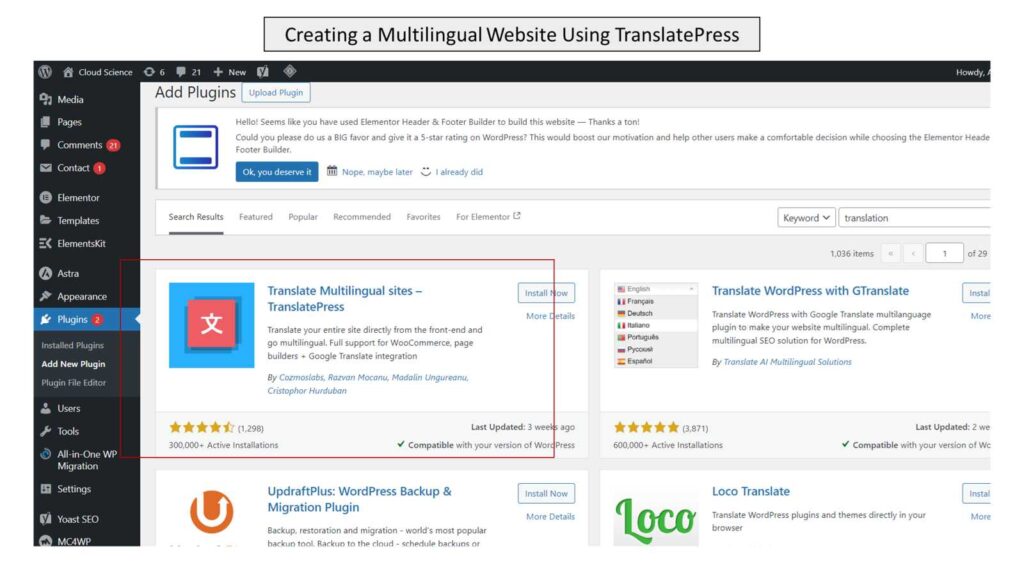
Step 2: Configure TranslatePress Settings
- After activation, go to the TranslatePress settings page.
- Choose your default language (the language your website is currently in).
- Select the languages you want to translate your website into.
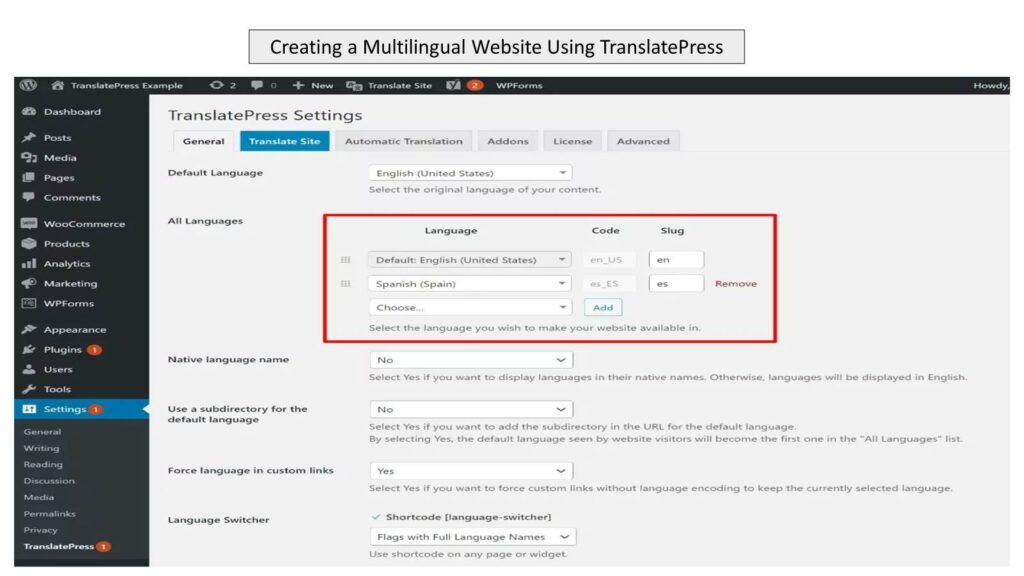
Step 3: Translate Your Website Content
- Navigate to the page or post you want to translate.
- Click on the TranslatePress icon at the top of the page to access the translation interface.
- Translate each element of your page, including text, images, and meta tags, by simply clicking on them and entering the translated content.
- Use the preview feature to see how your translated content will look on the front end.

Step 4: Translation Editor
You’ll encounter a familiar interface similar to the standard WordPress Customizer when using the translation editor.
- Hover over the relevant section in the live preview.
- Click on the pencil icon to modify or add translations.
- Use the dropdown menu on the left to search or browse through all displayed content on the page.

Once you choose an item to translate, you can directly make your edits in the sidebar.

Step 5: Test Your Multilingual Website
- Before going live, thoroughly test your multilingual website to ensure all translations are accurate and the language switcher functions correctly.
- Check for any layout or formatting issues that may arise due to translation.
By following these steps, you can effectively create a multilingual website using TranslatePress. This will enable you to reach a wider audience and provide a better user experience for visitors from different language backgrounds.
“Moving further now, let’s Discover the world of online translation tools that can help you break the language barriers and communicate with people from all over the globe without any difficulty. These top free tools are designed to provide accurate translations for various languages, making it easier to understand and connect with people from diverse backgrounds.”
Top Free Translation Tools Online
Let’s explore some of the top free translation tools and their features:
- Google Translate
- Microsoft Translator
- DeepL
- Bing Translator
- Yandex Translate
- PROMT Online
1. Google Translate
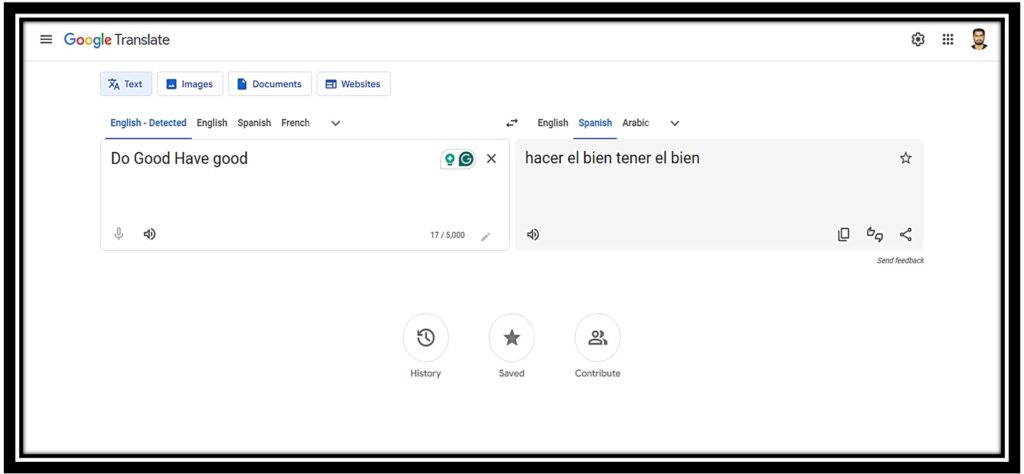
Google Translate is perhaps the most well-known tool, offering translations in over 100 languages. It provides text translation, website translation, and even real-time conversation translation through its mobile app. Google uses machine learning algorithms to improve translation accuracy over time.
Key Features:
- Text translation
- Website translation
- Mobile app for on-the-go translations
- Voice input for hands-free translation
- Offline translation capabilities
2. Microsoft Translator
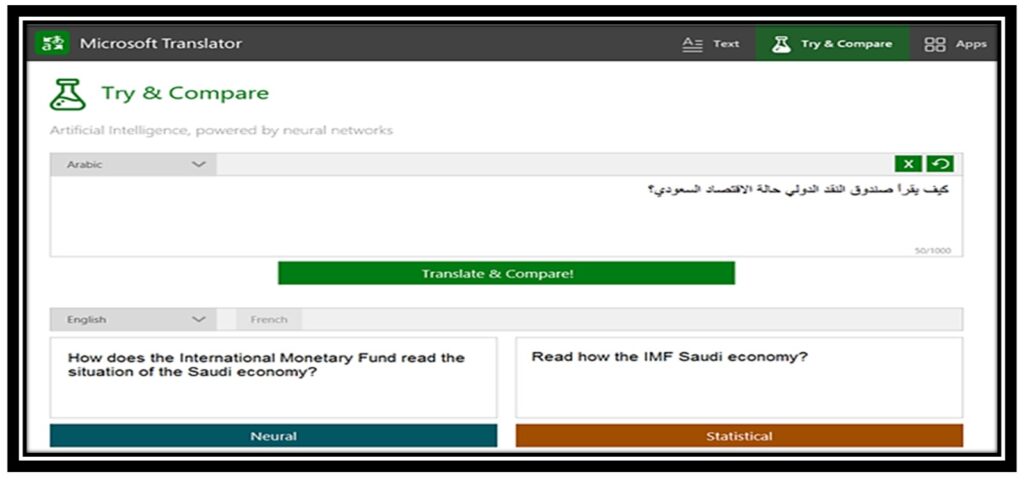
Microsoft Translator is another popular tool that supports a wide range of languages. It offers text translation, website translation, and document translation services. Microsoft also provides translation plugins for popular content management systems like WordPress and Joomla. Microsoft Translator is a cloud-based, enterprise-ready translation web API supporting 50 languages.
Key Features:
- Text translation
- Website translation
- Document translation
- Translation plugins for website integration
- Speech translation for conversations
- Supporting 50 languages
3. DeepL

DeepL is renowned for its high-quality translations, thanks to its advanced neural network technology. While DeepL primarily focuses on text translation, it offers superior translation accuracy compared to many other tools. DeepL also provides browser extensions for seamless integration with popular web browsers.
Key Features:
- Text translation
- High-quality translations
- Browser extensions for easy access
- Support for multiple languages
4. Bing Translator

Bing Translator, developed by Microsoft, offers text translation, website translation, and document translation services. It supports over 60 languages and provides accurate translations for various content types. Bing also offers a mobile app for on-the-go translations.
Key Features:
- Text translation
- Website translation
- Document translation
- Mobile app for translations
- Support for over 60 languages
5. Yandex Translate
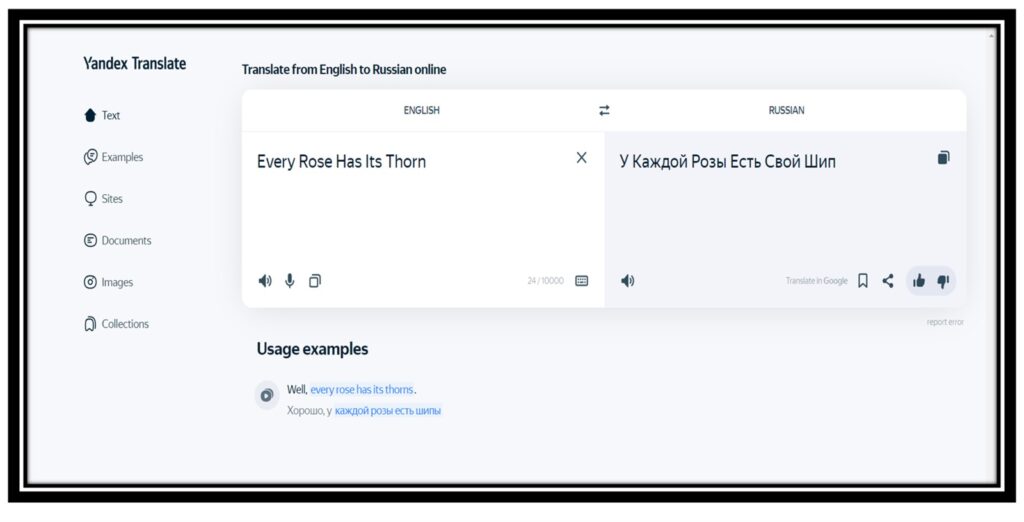
Yandex Translate provided by Yandex, a Russian multinational corporation. It offers text, website, and document translation services. Yandex Translate supports over 100 languages and provides accurate translations for various content types.
Key Features:
- Text translation
- Website translation
- Document translation
- Support for over 100 languages
- Voice input for translation
- Context-based translation suggestions
6. PROMT Online Translator
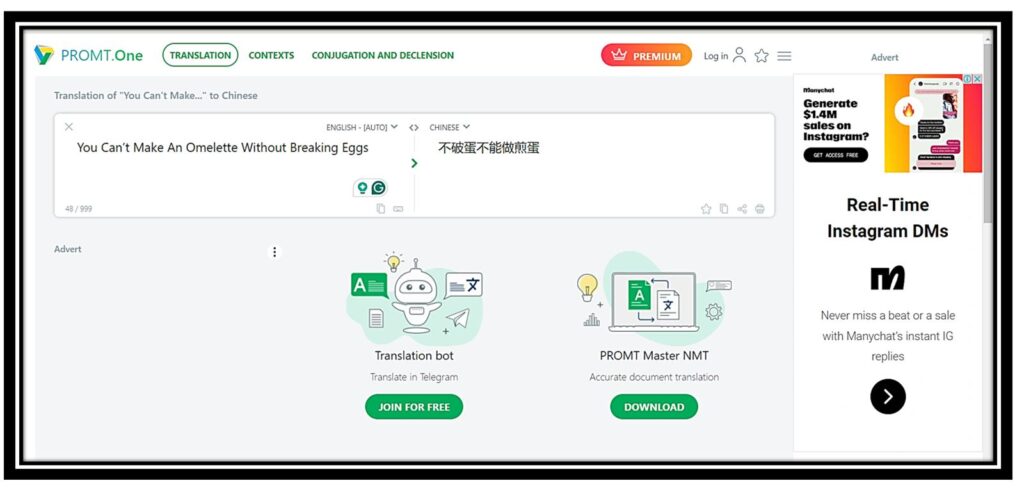
PROMT Online Translator is provided by PROMT, a Russian translation software company. It offers text, website, and document translation services. PROMT Online Translator supports over 20 languages and provides accurate translations for various content types.
Key Features:
- Text translation
- Website translation
- Document translation
- Support for over 20 languages
- Quick and reliable translations
- Context-based translation suggestions
Conclusion:
In 2024, website translation is indispensable for global outreach, user experience enhancement, and SEO improvement. Embracing website translation opens doors to diverse markets, fosters trust, and boosts brand visibility internationally. Additionally, it signals a commitment to inclusivity and cultural appreciation.
Frequently Asked Questions: Website Translations 2024
Website translation is crucial in 2024 to cater to an increasingly diverse global audience. With internet accessibility growing in non-English-speaking regions, translating your website allows you to reach and engage with a broader audience, leading to increased brand visibility and growth opportunities.
While automated translation tools offer convenience and speed, they may not always provide accurate translations, especially for complex or specialized content. It's advisable to combine automated translation with human review or professional translation services to ensure linguistic accuracy and cultural sensitivity.
To maintain the quality of translated content, it's essential to regularly review and update translations to reflect changes in language usage, context, and cultural nuances. Additionally, soliciting feedback from users or hiring professional translators for complex content can help ensure accuracy and clarity.
Best practices include optimizing metadata, using hreflang tags, creating language-specific sitemaps, and generating unique content for each language version. Conduct keyword research in target languages and implement SEO strategies accordingly.
Regular updates are essential to keep translated content accurate and relevant. Monitor changes in language usage, cultural trends, and industry developments to ensure timely updates and maintain user engagement.
Consider your target audience and their preferred languages when selecting languages for website translation. Analyze market research, user demographics, and global trends to make informed decisions.
Common challenges include linguistic nuances, cultural sensitivities, maintaining brand voice, and technical issues such as formatting and character limitations. Addressing these challenges requires careful planning and collaboration between translators and web developers.
While machine translation is convenient for basic content, it may not be suitable for complex or specialized content requiring accuracy and context. Consider using human translators for critical content areas to ensure quality and precision.



